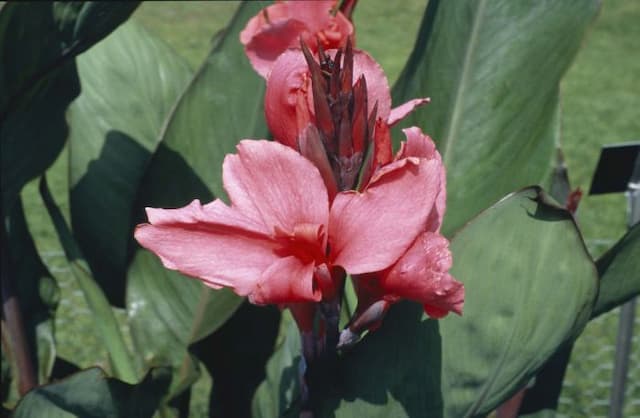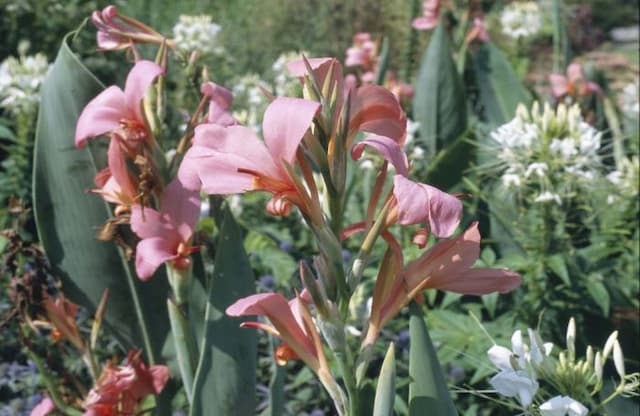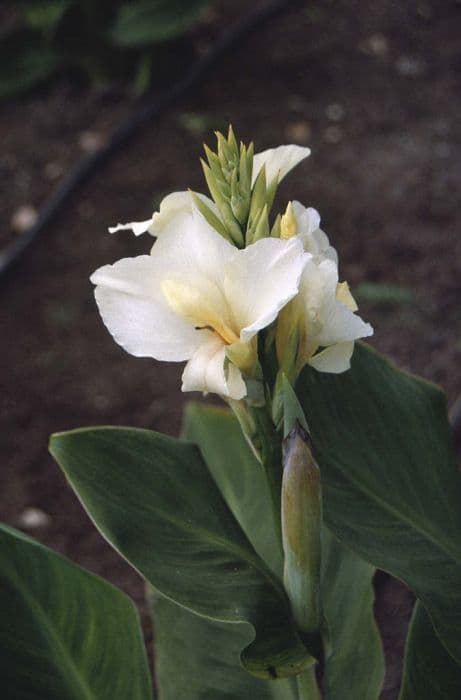Canna Lily Canna 'Annaeei'

ABOUT
The Canna 'Annei' is a vibrant and striking plant, primarily grown for its showy foliage and bright flowers. This plant features large, broad leaves that are typically tinted with green and sometimes have streaks or patches of various colors, such as bronze or maroon, depending on the variety. These leaves cascade from the plant in a lush, tropical manner, exuding an exotic charm. The flowers of the Canna 'Annei' are equally impressive, with bold and large petals that form a flared shape, resembling those of an iris. These blossoms may come in a range of colors, including reds, oranges, yellows, or pinks, often presenting a striking contrast against the foliage. The petals have a somewhat waxy texture and can be somewhat ruffled, adding to their ornate appearance. Overall, the Canna 'Annei' is a robust and flamboyant plant that adds a splash of color and a tropical flair to any garden setting. Its rich and glossy foliage, combined with the ornamental, attention-grabbing flowers, makes it a favorite amongst gardeners looking to create a dramatic and visually engaging landscape.
About this plant
 Names
NamesSynonyms
Garden Canna, Canna Lily, Indian Shot
Common names
Canna 'Annei'.
 Toxicity
ToxicityTo humans
Canna, commonly known as canna lily, is not considered toxic to humans. While the plant is not intended for consumption and may cause discomfort if ingested, canna lilies do not have toxic properties that are harmful to humans. Therefore, accidental ingestion is not expected to cause severe poisoning. However, it's generally advisable to avoid eating ornamental plants due to the potential for individual allergic reactions or gastrointestinal upset.
To pets
Canna lilies are not known to be toxic to pets, such as cats and dogs. They are generally regarded as safe plants in terms of pet health and are not listed as poisonous to animals. If a pet ingests part of a canna lily, it might experience mild gastrointestinal discomfort, but severe toxicity or poisoning is unlikely. However, as with humans, it's usually best to prevent pets from eating ornamental plants to avoid any potential issues.
 Characteristics
CharacteristicsLife cycle
Perennials
Foliage type
Deciduous
Color of leaves
Green
Flower color
Varies
Height
4-6 feet (1.2-1.8 meters)
Spread
1.5-2 feet (0.45-0.6 meters)
Plant type
Bulb
Hardiness zones
7
Native area
South America
Benefits
 General Benefits
General Benefits- Ornamental Value: Canna 'Annaeei' adds aesthetic appeal to gardens with its large, tropical-looking foliage and vibrant flowers, which can enhance any landscape design.
- Ease of Care: This plant requires minimal maintenance, making it a convenient choice for busy gardeners or those new to gardening.
- Drought Resistance: Once established, it is quite tolerant of drought, reducing the need for frequent watering and saving on water resources.
- Rapid Growth: Canna 'Annaeei' grows fairly quickly, which is beneficial for gardeners looking to achieve a full, lush garden in a short period of time.
- Attracts Pollinators: The flowers are attractive to pollinators like bees and butterflies, supporting biodiversity and benefiting the local ecosystem.
 Medical Properties
Medical PropertiesThis plant is not used for medical purposes.
 Air-purifying Qualities
Air-purifying QualitiesThis plant is not specifically known for air purifying qualities.
 Other Uses
Other Uses- Canna 'Annaeei' leaves can be used as a natural wrapping material for cooking, similar to banana leaves, due to their size and durability.
- The starchy rhizomes of canna lily can be processed to produce biodegradable plastics as an eco-friendly alternative to traditional plastics.
- The fibrous content of canna lily stems and leaves can be explored for paper-making, offering a sustainable source of pulp.
- Canna lily can be incorporated into living water filtration systems to help remove contaminants from water bodies naturally.
- The large leaves of canna lily can be utilized in crafts for making eco-friendly hats and other woven goods.
- Canna lily seeds, being hard and dense, can be employed as beads or in the creation of musical instruments like shakers.
- Due to their rapid growth, canna lily plants can be used for temporary privacy screens or hedges in gardens and landscapes.
- The vibrant flowers of canna lily serve as a natural dye source for fabrics and other materials.
- Canna lily rhizomes can serve as a food for fish or livestock when properly prepared and deemed safe for ingestion by the specific species.
- In some cultures, canna lily is used in ceremonies and rituals as a decorative element due to its striking appearance.
Interesting Facts
 Feng Shui
Feng ShuiThe Canna is not used in Feng Shui practice.
 Zodiac Sign Compitability
Zodiac Sign CompitabilityThe Canna is not used in astrology practice.
 Plant Symbolism
Plant Symbolism- Exotic Beauty: The Canna 'Anneei', with its bold leaves and vibrant flowers, represents beauty that is both exotic and striking, often associated with tropical or unique aesthetics.
- Confidence: The plant's upright growth and presence can symbolize self-assurance and the confidence to stand out in a crowd.
- Creativity: Canna flowers come in a range of vivid colors, which can symbolize creativity and the vibrancy of imagination.
- Prosperity: In some cultures, Canna's lush growth is associated with abundance and prosperity, reflecting a flourishing or successful state.
 Water
WaterCannas, including the Canna 'Annaeei', prefer consistent moisture and should not be allowed to dry out completely between waterings. They often require watering at least once a week during active growth, but the frequency might increase to every other day in extremely hot temperatures. A good rule of thumb is to provide them with about 1 to 1.5 gallons of water per week, depending on rainfall and temperature conditions. It's generally better to water deeply and less frequently rather than shallow and often. Ensure the soil is well-draining to prevent waterlogging.
 Light
LightCannas, which would include the Canna 'Annaeei', thrive in full sun and should be placed in a location where they will receive at least 6 hours of direct sunlight each day. They can tolerate some light shade, but too much shade can reduce blooming and weaken the plant. The ideal spot for a Canna plant is in an area with bright, unfiltered sunlight, which encourages healthy growth and vibrant flowers.
 Temperature
TemperatureThe Canna 'Annaeei' prefers warm conditions and typically grows best in temperatures ranging from 60 to 90 degrees Fahrenheit. They can survive in temperatures as low as 55 degrees Fahrenheit but will start to suffer damage if the temperature drops much below this mark. Cannas are not frost-tolerant and should be protected or moved indoors if temperatures are expected to fall below 55 degrees Fahrenheit.
 Pruning
PruningThe Canna 'Annaeei' should be pruned to remove old flowers and seed pods to encourage further blooming throughout the season. Pruning is also necessary to remove any damaged or diseased foliage, which can occur periodically. The best time for pruning is after flowering, and it's typically done seasonally or when necessary to maintain plant health and aesthetics.
 Cleaning
CleaningAs needed
 Soil
SoilFor Canna Lily 'Annaeei', a well-draining soil mix is ideal, comprising equal parts of loam, peat, and perlite or sand. A pH level of 6.0 to 6.5 is best for this plant, ensuring proper nutrient absorption.
 Repotting
RepottingCanna Lily 'Annaeei' should be repotted every two to three years or when it outgrows its current pot. They are typically repotted in spring before the new growth season.
 Humidity & Misting
Humidity & MistingCanna Lily 'Annaeei' thrives in moderate to high humidity levels, around 40-60%. They do well in the naturally higher humidity of outdoor settings.
 Suitable locations
Suitable locationsIndoor
Place in bright, indirect light, and keep soil evenly moist.
Outdoor
Plant in full sun, enrich soil with compost, ensure good drainage.
Hardiness zone
7-11 USDA
 Life cycle
Life cycleThe life of the Indian Shot (Canna 'Annéei') begins with seed germination, where the tough-coated seeds need to be scarified or soaked to encourage the sprouting process, followed by emergence of the seedling. Once they germinate, seedlings will grow into vegetative plants, developing broad leaves and sturdy stems as they mature. The plant then enters the flowering stage, producing vibrant blossoms that attract pollinators, although many Canna varieties, including 'Annéei', are often propagated via rhizomes rather than seeds. After pollination, the flowers will wither and the plant may produce seeds contained within a capsule, though vegetative propagation is more reliable for maintaining specific cultivar traits. The foliage continues to grow until the plant is affected by the first frost, at which point the above-ground portions die back, but the rhizomes can survive underground in warmer climates or can be stored for the winter in colder regions. The cycle is completed as the rhizomes can be divided and replanted, giving rise to new plants in the following growing season.
 Propogation
PropogationPropogation time
Spring-Early Summer
The Canna Lily, commonly referred to as Canna 'Annaeei', is typically propagated through division, which is the most popular method for this plant. This process involves splitting the rhizomes, which are the underground stems of the plant, during the spring or early summer when the plant is coming out of dormancy. The gardener should carefully dig around the plant to lift the rhizomes from the ground, then using a sharp knife or spade, divide them into sections ensuring each section has at least one eye, which is a growth point. These sections are then replanted into moist, well-draining soil at a depth of about 4 inches (approximately 10 cm), taking care to space them out to allow room for growth. The divisions should be watered thoroughly after planting to help establish the new plants.









